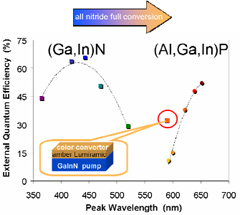Monochromatic light-emitting diodes cover a large part of the visible spectrum with high efficiency. For blue light, nitride diodes achieve external quantum efficiencies in excess of 65%, i. e., one photon is emitted for approx. 2/3 of the electron-hole pairs injected into the diode. For red light, phosphor diodes achieve efficiencies of approx. 50%.
 A nitride phosphor with peak emission at 590 nm in the form of a dense ceramic – Lumiramic™ is attached to a highly efficient blue emitting InGaN diode, so that full conversion of blue light is achieved. A total External Quantum Efficiency (amber photons per electron) of 32% has been reached, resulting in a 300% improvement over the best direct AlGaInP LED
A nitride phosphor with peak emission at 590 nm in the form of a dense ceramic – Lumiramic™ is attached to a highly efficient blue emitting InGaN diode, so that full conversion of blue light is achieved. A total External Quantum Efficiency (amber photons per electron) of 32% has been reached, resulting in a 300% improvement over the best direct AlGaInP LED
However, so far no highly efficient monochromatic LEDs have been available for the "yellow gap" at around 560 nm. Now researchers with Philips Lumileds have developed a monochromatic nitride diode that closes this gap.
The phosphor converted (PC) amber LED demonstrated by Regina Mueller-Mach and her colleagues uses the down conversion of blue light from an InGaN LED to longer-wavelength light by a phosphor.
This is a well-established method for producing e.g. cold or warm white light from blue LED light for various applications.
Four years ago, Philips Lumileds researchers were already producing LEDs for warm white light, using a europium-doped barium strontium nitride phosphor for the down conversion. They noticed that, depending on the Ba/Sr ratio and the Eu doping concentration, colored light of different wavelengths could also be produced. The exact choice of pump wavelength did not matter.
Now the researchers succeeded in down-converting blue LED light into monochromatic amber light with a 595 nm wavelength and a color purity of 98,7%. The external quantum efficiency of the PC amber LED is at 30-40%, depending on temperature. Compared to direct amber LEDs, the new PC amber LED is two to five times as bright. It achieves a light output of 70 lumen at a 350mA current.
The new phosphor can be produced in polycrystalline ceramic form. This luminescent ceramic very efficiently absorbs the activating blue light. Another advantage is the fact that the optical qualities of the phosphor are influenced by temperature only to a small extent. According to measurement results, the color stability with drive current and temperature is excellent.
There are numerous applications for the LUXEON Rebel PC Amber LED. It can be used in yellow traffic lights or signals as well as in cars' turn signals or warning lights for construction sites. They could also be used in consumer electronics. Their high efficiency makes them inexpensive. The yellow gap could be a thing of the past even in everyday life.